South Kazakhstan is a region located in the southern part of the Central Asian state. It is home to many birds, some of which are found nowhere else. The region boasts many habitats, from mountains and steppes to deserts and wetlands.
These habitats provide a rich diversity of bird species, from large predators like vultures and eagles to small songbirds and game birds. South Kazakhstan is also a central stopover point for migratory birds on their way to and from their breeding grounds in the region.
There are several protected areas where bird watchers can observe and appreciate these amazing creatures. South Kazakhstan is an ideal destination for bird watchers, as its varied landscapes and habitats make it a paradise for avian enthusiasts.
24 Birds to Watch in South Kazakhstan
South Kazakhstan has diverse landscapes, from the arid deserts and steppes to the lush valleys and mountains. It is also home to various birds, some endemic or rare.
Whether a casual birdwatcher or a serious ornithologist, you will find plenty of opportunities to observe and admire these feathered creatures.
Here are 24 birds that you should not miss when visiting South Kazakhstan.
1. Black-winged Stilt
The black-winged stilt is a species of wader or shorebird found in many parts of the world. It belongs to the avocet and stilt family and is known for its long legs. The scientific name for this species is H. himantopus.
This species has a wide distribution and is almost cosmopolitan, meaning it can be found on all continents except Antarctica. It is a pretty common species and is present in both fresh and saltwater habitats.
The black-winged stilt has a long, slender body and long, thin legs. The bird’s head, neck, and upperparts are black, while its underparts are white. Its wings are black and white, and its bill is black. The bird has a reddish-brown eye, and its legs are grayish-black.
The black-winged stilt is usually seen in small flocks and feeds on small insects, crustaceans, and other invertebrates. The black-winged stilt is a migratory species, and its range expands in the winter months.
It is found in many parts of North America, Europe, and Asia, as well as in South Africa, Australia, and New Zealand. It is a relatively hardy bird and can thrive in many habitats, from wetlands and marshes to open fields and mudflats.
The black-winged stilt is an important species, as it plays a role in the health of its wetland habitats. Its presence helps maintain the balance of invertebrate populations and contributes to the nutrient cycle in these habitats.
Its long legs make it uniquely adapted to foraging in shallow water and play an essential role in the wetland food web.
| Kingdom | Animalia |
| Phylum | Chordata |
| Class | Aves |
| Order | Charadriiformes |
| Family | Recurvirostridae |
| Genus | Himantopus |
| Species | H. himantopus |
2. Tufted Duck
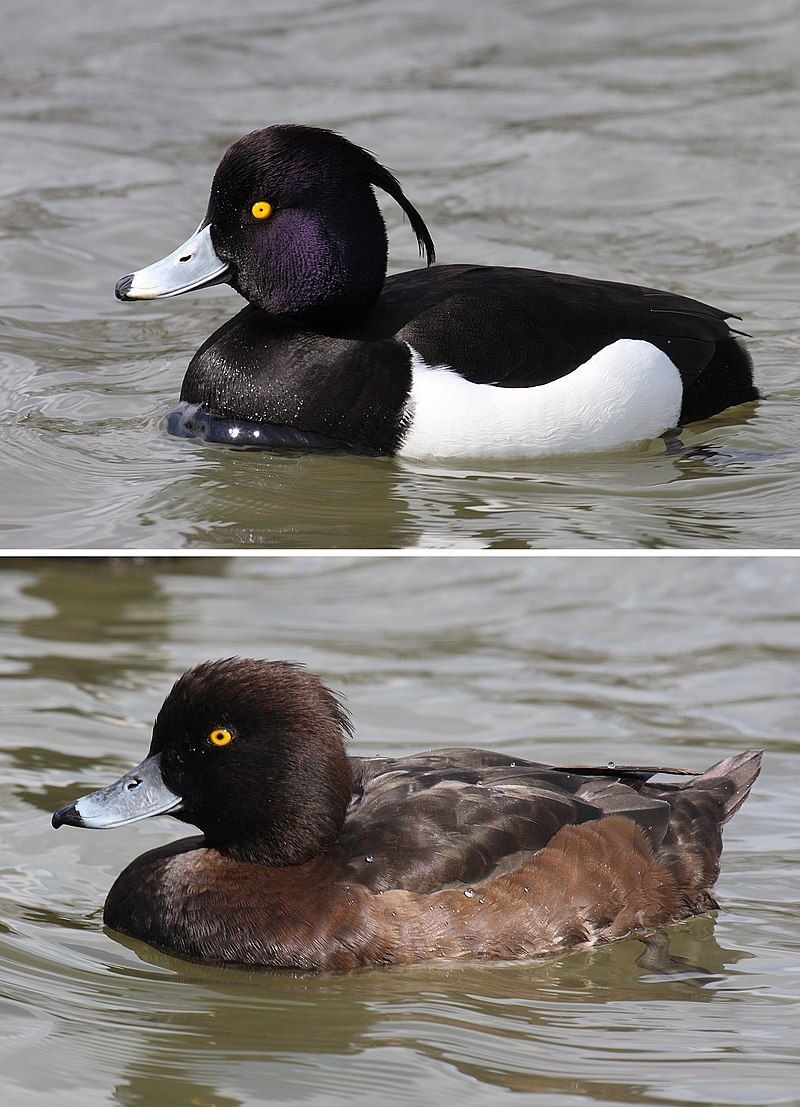
The tufted duck, also known as the tufted pochard, is a small diving duck native to northern Eurasia. It is estimated that close to one million birds of this species live in the wild.
The scientific name of the tufted duck is derived from two sources: Ancient Greek and Latin. Lithuania was an unidentified seabird mentioned by authors such as Hesychius and Aristotle. The Latin logo translates to “soot,” and gula translates to “throat.”
This is about the tufted duck’s distinctive black-and-white markings around its throat. This duck species is easily recognizable due to its unique coloration and signature tufted crown.
| Kingdom | Animalia |
| Phylum | Chordata |
| Class | Aves |
| Order | Anseriformes |
| Family | Anatidae |
| Genus | Aythya |
| Species | A. fuligula |
3. Ferruginous Duck
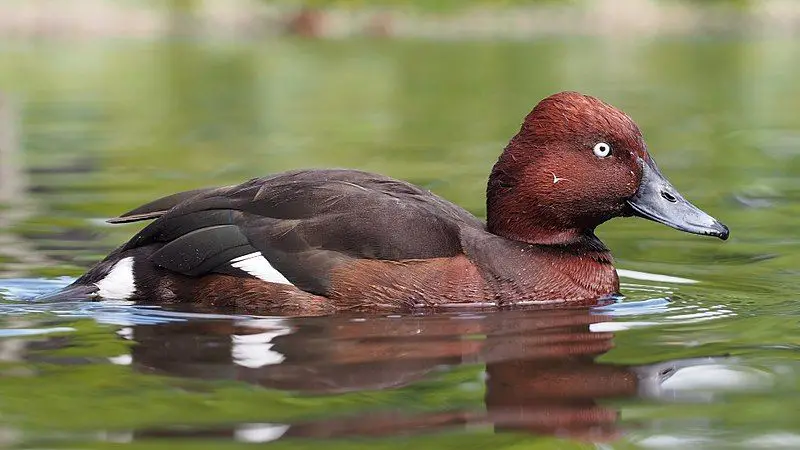
The ferruginous duck is a unique waterfowl found throughout Eurosiberia. Other names, such as ferruginous pochard, common white-eye, and white-eyed pochard, also know it.
This bird typically grows to a medium size and is a diving duck, which means it dives underwater to find food. The scientific name for this duck is derived from Greek, precisely the words Lithuania and nyrok.
Aithuia was an unidentified seabird mentioned in ancient texts, such as by authors Hesychius and Aristotle. Nyrok is the Russian term for a duck. This is an exciting example of how scientific names often come from various sources.
| Kingdom | Animalia |
| Phylum | Chordata |
| Class | Aves |
| Order | Anseriformes |
| Family | Anatidae |
| Genus | Aythya |
| Species | A. nyroca |
4. Bar-headed Goose
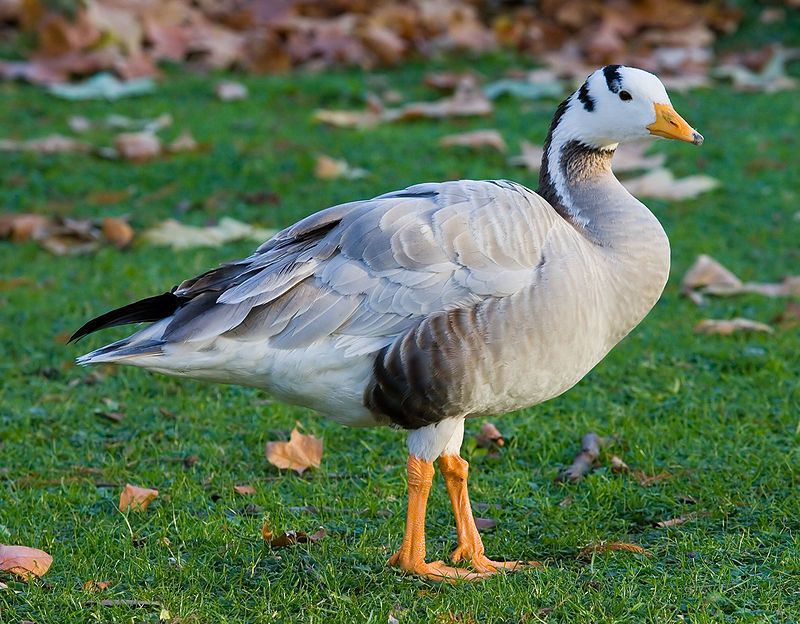
The bar-headed goose is a species of goose that is found in Central Asia and South Asia. It breeds in large colonies near mountain lakes, laying three to eight eggs in a ground nest at a time. During the winter months, it migrates south as far as peninsular India.
What is unique about this goose species is its ability to fly at extreme altitudes when crossing the Himalayas during migration.
It is believed to be the highest-flying bird in the world, reaching altitudes of up to 7,000 meters, which is higher than many commercial airplanes fly.
The bar-headed goose can have these extreme altitudes due to its large body size, strong wings, and unique respiratory system, allowing more oxygen.
This goose species is a remarkable animal, and its ability to fly at such extreme altitudes is genuinely impressive.
| Kingdom | Animalia |
| Phylum | Chordata |
| Class | Aves |
| Order | Anseriformes |
| Family | Anatidae |
| Genus | Anser |
| Species | A. indicus |
5. Red-breasted Goose
The red-breasted goose is a species of goose belonging to the genus Branta. It is found mainly in Eurasia and is easily identified by its brightly colored plumage.
According to the International Union for Conservation of Nature (IUCN), this species is considered vulnerable. This means that its population is declining, and it is essential to take steps to protect this species.
The red-breasted goose has a black head, neck, chest, white face, and bright red throat. It has a white belly, grey back, and black wings with white trailing edges. It has a dark brown bill, yellow legs and feet, and a white tail.
Its diet consists mainly of plant material, including grasses, aquatic plants, and grains. It also eats small invertebrates and insects. The red-breasted goose is a migratory species, breeding in wetlands in Eurasia’s taiga and tundra regions.
During winter, they migrate south to areas in Europe, Asia, and northern Africa. They form large flocks and are usually seen in wetlands, lakes, and rivers.
The red-breasted goose is threatened by the destruction of its habitat due to agricultural and urban development. Hunting and egg collecting also contribute to the decline in its population. It is also at risk due to non-native species in its range.
Conservation efforts are needed to help protect this species and its habitat.
| Kingdom | Animalia |
| Phylum | Chordata |
| Class | Aves |
| Order | Anseriformes |
| Family | Anatidae |
| Genus | Branta |
| Species | B. ruficollis |
6. Common Cuckoo
The common cuckoo belongs to a group of birds known as Cuculiformes. This group includes a variety of species, such as roadrunners, anis, and coucals. The common cuckoo is a widely distributed summer migratory bird commonly found in Europe and Asia.
It migrates to Africa when winter arrives, where it spends the colder months. Its migration is integral to its lifecycle, allowing it to breed in more favorable conditions. These birds have a unique relationship with other species of birds.
The female cuckoo will lay her eggs in the nest of another bird species, and the host bird will unknowingly incubate and feed the cuckoo chicks, often to the detriment of its own young.
This behavior is beneficial to the cuckoo because it ensures that its young will receive the necessary care and protection to survive. The common cuckoo is an essential species in its environment, playing a vital role in the food chain.
It is a predator of a wide variety of insects and also helps to disperse seeds of certain species of plants, contributing to their spread and growth. The common cuckoo is a fascinating species that fascinates biologists and birdwatchers alike.
Its unique lifestyle and its migratory behavior make it an exciting subject of study.
| Kingdom | Animalia |
| Phylum | Chordata |
| Class | Aves |
| Order | Cuculiformes |
| Family | Cuculidae |
| Genus | Cuculus |
| Species | C. canorus |
7. Long-tailed Duck
The long-tailed duck, formerly known as the oldsquaw, is a unique sea duck species in the world’s far north.
It is a medium-sized bird well adapted to the cold climates of the Arctic and spends its summers in the tundra and taiga regions. During the winter months, it can be found along the northern coastlines of the Atlantic and Pacific Oceans.
The long-tailed duck is the only member of its genus, Clangula, and is easily identified by its distinctive long tail feathers. This duck species is quite hardy and can survive in some of the harshest environments in the world.
It is a remarkable species, and its adaptability and resilience are a testament to the power of nature.
| Kingdom | Animalia |
| Phylum | Chordata |
| Class | Aves |
| Order | Anseriformes |
| Family | Anatidae |
| Genus | Clangula |
| Species | C. hyemalis |
8. Ibisbill
The ibisbill is a unique and distinct bird that belongs to its family, Ibidorhynchidae, which is related to the waders. Its appearance is different and stands out from other birds, with its grey-colored body, white belly, red legs, and long down-curved bill.
It also has a black face and black breast band. This bird species is usually found in the high plateau of central Asia and the Himalayas, where it can be seen on the shingle riverbanks.
Its unique physical features and habitat make it an interesting species to observe and study.
| Kingdom | Animalia |
| Phylum | Chordata |
| Class | Aves |
| Order | Charadriiformes |
| Family | Ibidorhynchidae |
| Genus | Ibidorhyncha |
| Species | I. struthersii |
9. Black Stork
The black stork is a large and distinctive bird species belonging to the Ciconiidae family of storks. It was first described by the renowned Swedish naturalist Carl Linnaeus in the 10th edition of his famous work, Systema Naturae.
The black stork is a large bird with a body length of up to 80 cm and a wingspan of up to 190 cm. It has a blackish-blue plumage on its back and wings, with a white head, neck, and underparts. Its long, thick bill is bright red, and its legs and feet are black.
The black stork has a long history of symbolizing luck and good fortune in many cultures. It has been featured in several folk tales and is often associated with wisdom, knowledge, and fertility in many cultures.
The black stork is a wide-ranging species in parts of Europe, Asia, and Africa. Due to its large population and wide distribution, it is listed as a species of most minor concern by the IUCN.
| Kingdom | Animalia |
| Phylum | Chordata |
| Class | Aves |
| Order | Ciconiiformes |
| Family | Ciconiidae |
| Genus | Ciconia |
| Species | C. nigra |
10. Demoiselle Crane
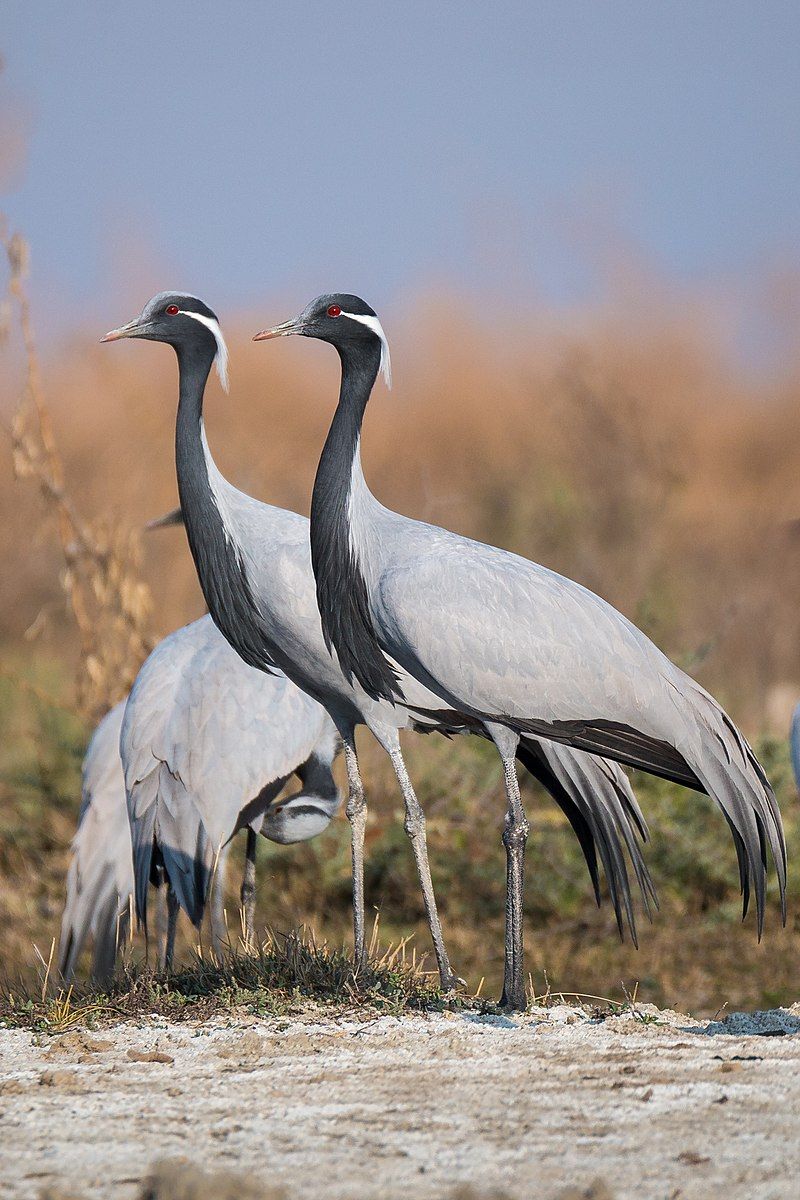
The demoiselle crane is an iconic species of crane found in Central Eurosiberia. It inhabits a range stretching from the Black Sea to Mongolia and Northeast China, and Turkey has a small breeding population.
The demoiselle crane is a migratory bird that undertakes long journeys to reach its wintering grounds. During the springtime, the demoiselle crane will travel to its breeding grounds, and during the fall, it will migrate to its wintering grounds.
This crane species has adapted to survive in various habitats, including wetlands, grasslands, and open woodlands. During its breeding season, the demoiselle crane will build its nest on the ground, usually near water.
Its diet consists of small invertebrates, seeds, and grains. The demoiselle crane is an important species, not only because of its beauty and its importance to the ecosystem but also due to its symbolic meaning in many cultures.
| Kingdom | Animalia |
| Phylum | Chordata |
| Class | Aves |
| Order | Gruiformes |
| Family | Gruidae |
| Genus | Grus |
| Species | G. virgo |
11. Greater Flamingo
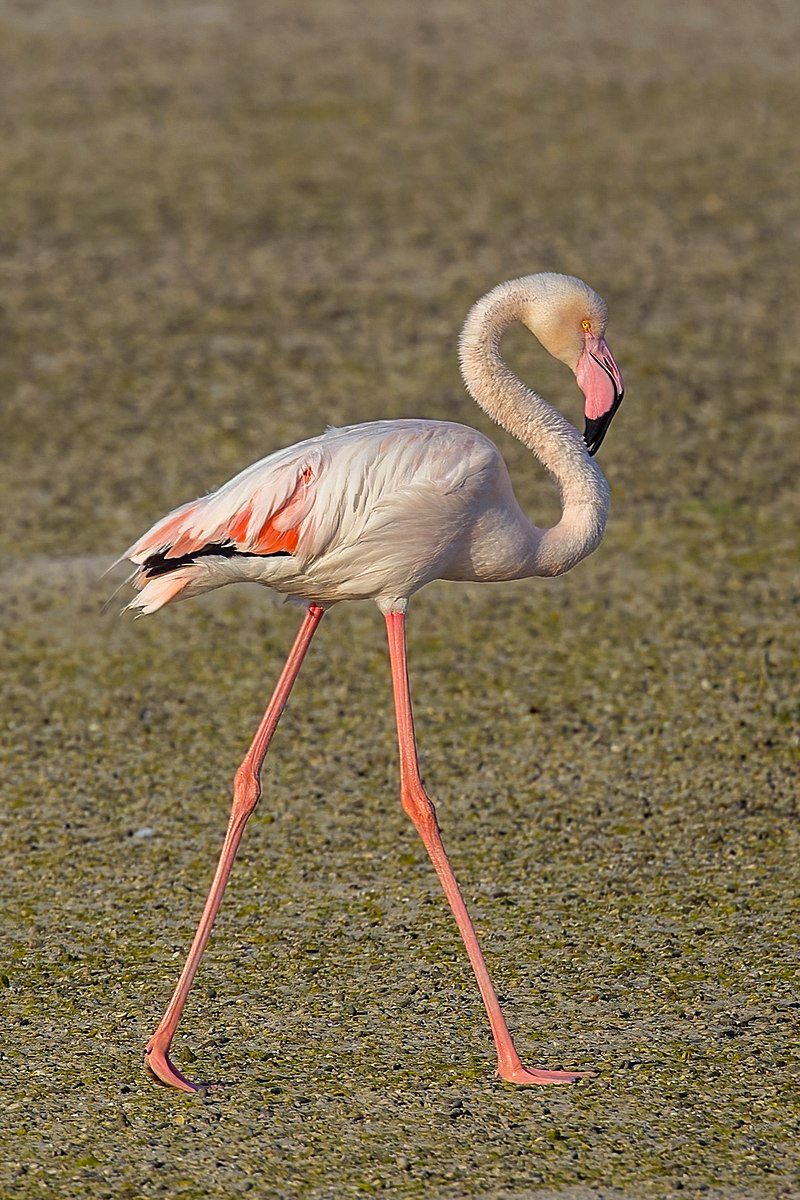
The greater flamingo is the family’s most widespread and most significant species, found throughout the Old World.
Commonly found in Northern and Sub-Saharan Africa, as well as parts of the Indian Subcontinent, the Middle East, the Levant, the Persian Gulf, the Gulf of Aden, the Red Sea, and the Mediterranean countries of Southern Europe, these birds are the most widespread species of flamingo.
The greater flamingo has adapted to various habitats, from wetlands to coastal areas and even some deserts.
They inhabit lakes, rivers, lagoons, estuaries, mudflats, shallow seas, and even saline and alkaline lakes.
They are known to congregate in large flocks, sometimes numbering into the thousands. These birds are a vibrant pink, often with a pinkish-orange beak and legs. They have long necks and long legs, which they use to wade in shallow waters to search for food.
Their diet mainly consists of brine shrimp and other tiny aquatic organisms. The greater flamingo is an essential species in the Old World, linking the wetland and coastal areas between Northern and Sub-Saharan Africa.
The Indian Subcontinent, the Middle East, the Levant, the Persian Gulf, the Gulf of Aden, the Red Sea, and the Mediterranean countries of Southern Europe.
They provide a vital food source for many species and an essential habitat for many aquatic organisms.
| Kingdom | Animalia |
| Phylum | Chordata |
| Class | Aves |
| Order | Phoenicopteriformes |
| Family | Phoenicopteridae |
| Genus | Phoenicopterus |
| Species | P. roseus |
12. Pallas’s Sandgrouse
Pallas’s sandgrouse is a species of bird that is part of the sandgrouse family. The bird is considered medium to large, with a wingspan that can range from 16.5 to 21.7 inches.
It is found throughout much of Eurasia, including parts of Russia, Kazakhstan, Mongolia, and western China. This sandgrouse species is distinct from other family members because of its habitat preferences.
While other sandgrouse species will inhabit desert regions, Pallas’s sandgrouse prefers to inhabit grassland areas or steppes. This sandgrouse species has a unique diet consisting mainly of grass seeds, which it extracts from the ground with its bill.
It also feeds on insects, which are grabbed from the ground’s surface. The bird’s plumage is pale brown, with a darker brown band across its back. The males of this species have a white belly and a black patch of feathers on their necks.
The females are similar in appearance, but they lack the black patch on the neck. Pallas’s sandgrouse is an essential species for the areas it inhabits, as it helps disperse grass seeds necessary for vegetation growth.
| Kingdom | Animalia |
| Phylum | Chordata |
| Class | Aves |
| Order | Pterocliformes |
| Family | Pteroclidae |
| Genus | Syrrhaptes |
| Species | S. paradoxus |
13. Common Merganser
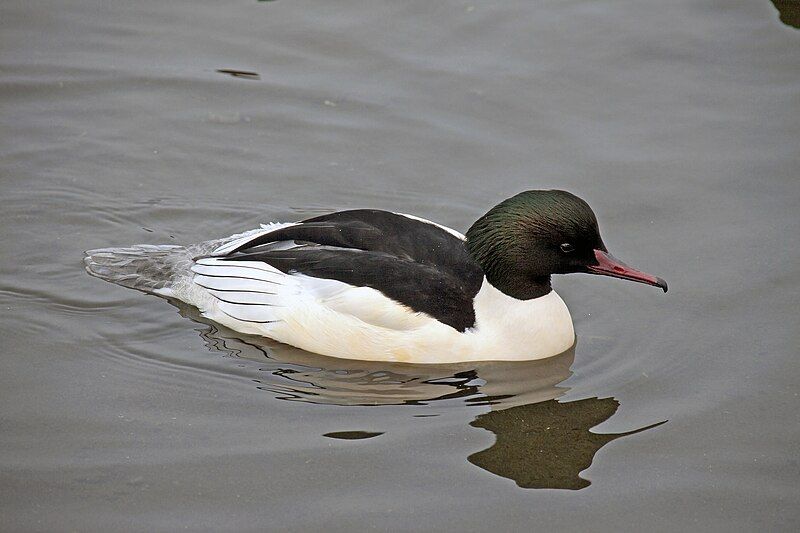
The Common Merganser is a species of duck found in rivers, lakes, and other bodies of water in forested areas across Europe, Asia, and North America. It is one of the larger seaducks with a wingspan of up to 65 inches.
This species is also known as the Goosander. The Common Merganser’s diet mainly consists of fish, with other aquatic animals, amphibians, and insects making up a smaller portion of its diet.
Its unique way of hunting for food involves diving beneath the water’s surface and using its sharp, serrated bill to grab its prey. The Common Merganser is a cavity nester, meaning it prefers to nest within the hollows of trees.
It will excavate its own nest if needed or will make use of existing holes in trees. The nest is lined with down feathers to provide insulation and cushioning for the eggs. The International Union for Conservation of Nature lists this species as the slightest concern.
This is due to its large population size and widespread distribution across three continents. Despite this, habitat loss and human disturbance still threaten the Common Merganser.
| Kingdom | Animalia |
| Phylum | Chordata |
| Class | Aves |
| Order | Anseriformes |
| Family | Anatidae |
| Genus | Mergus |
| Species | M. merganser |
14. Red-crested Pochard

The red-crested pochard is a large diving duck native to various parts of Europe, Asia, and Africa. Its distinctive red crest quickly identifies it, and it is a widespread duck species among bird watchers.
The scientific name of the red-crested pochard is derived from the Greek word Netta, meaning “duck”, and the Latin word Rufina, meaning “golden-red”. This scientific name indicates the bird’s appearance, with its golden-red crest and other reddish plumage.
The red-crested pochard is a relatively large duck, typically measuring 19-21 inches long and weighing up to 2.2 pounds. It has a dark body with a white patch near the tail and a distinctive red crest on its head. Its beak is usually a dark gray or black color.
The red-crested pochard is a powerful flier often seen flying in small flocks. It is a strong diver and feeds mainly on aquatic plants, invertebrates, and small fish.
The red-crested pochard is not considered to be threatened, although its population has declined due to hunting and habitat destruction.
| Kingdom | Animalia |
| Phylum | Chordata |
| Class | Aves |
| Order | Anseriformes |
| Family | Anatidae |
| Genus | Netta |
| Species | N. rufina |
15. White-headed Duck
The White-headed Duck (Oxyura leucocephala) is a small diving duck, typically 45 cm long. It can be found in Europe, North Africa, and Central and East Asia. The male has a white head with a black crown, a blue bill, and reddish-grey plumage.
In contrast, the female has a dark bill and duller coloring. When breeding, the White-headed Duck prefers lakes with open water and dense vegetation at the margins. This vegetation provides protection and shelter for the duck while it is nesting.
The duck also uses this vegetation to forage for food, such as insects, invertebrates, and small fish. During the winter, the White-headed Duck may migrate to more temperate climates.
The White-headed Duck is listed as a vulnerable species by the International Union for Conservation of Nature and Natural Resources (IUCN). This is due to the decline in population size due to habitat destruction, hunting, and other human activities.
Thus, conservation efforts are needed to ensure this species remains a part of our planet’s natural heritage.
| Kingdom | Animalia |
| Phylum | Chordata |
| Class | Aves |
| Order | Anseriformes |
| Family | Anatidae |
| Genus | Oxyura |
| Species | O. leucocephala |
16. Shikra
The shikra is a small bird of prey found across Asia and Africa. It is a member of the Accipitridae family and is also known as the little banded goshawk.
It is believed that the African forms of the shikra may be a separate species, but they have traditionally been treated as subspecies of the shikra. This means they are closely related to the shikra but have distinct characteristics that set them apart.
The shikra is a generalist predator, meaning it has a wide range of prey it can feed on. It also has a wide range of habitats in which it thrives, including forests, savannahs, grasslands, and urban areas.
The shikra is an integral part of the food web in its natural habitats, providing a valuable prey source for other animals and birds.
| Kingdom | Animalia |
| Phylum | Chordata |
| Class | Aves |
| Order | Accipitriformes |
| Family | Accipitridae |
| Genus | Accipiter |
| Species | A. badius |
17. Golden Eagle
The golden eagle is a large bird of prey native to the Northern Hemisphere. It is part of the family Accipitridae, which includes all eagles, hawks, kites, harriers, and Old World vultures.
These birds are powerful predators and can be found in various habitats, such as mountains, deserts, grasslands, forests, and wetlands. Golden eagles are known for their impressive wingspan, which ranges from five to seven and a half feet.
They have sharp talons and beaks for grabbing and tearing prey, and they use their keen eyesight to spot their victims from high in the sky. Golden eagles are mighty and can carry large prey items away from their nests.
These birds are considered a symbol of strength and courage and are among the best-known and most admired birds of prey in the Northern Hemisphere.
| Kingdom | Animalia |
| Phylum | Chordata |
| Class | Aves |
| Order | Accipitriformes |
| Family | Accipitridae |
| Genus | Aquila |
| Species | A. chrysaetos |
18. White-tailed Eagle
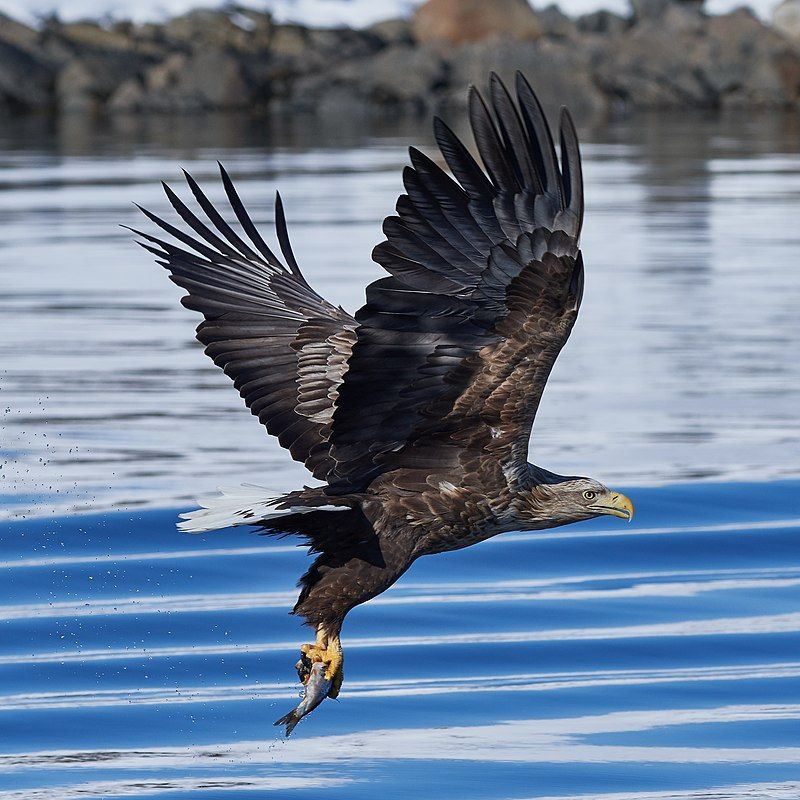
The white-tailed eagle, also known as the ‘sea eagle, ‘ is a large bird of prey in temperate climates throughout Europe and Asia.
It belongs to the family Accipitridae, which comprises other birds of prey that hunt during the day, such as hawks, kites, and harriers.
The white-tailed eagle is a giant bird with a wingspan of up to 2.45 meters long and a weight of up to 6.5 kilograms.
It has a distinctive white tail, a dark brown body, a paler head, and a neck. The white-tailed eagle is a mighty hunter, capable of taking a wide range of prey from the ground and the air.
It primarily feeds on fish and takes birds, small mammals, and even carrion. It has strong feet equipped with sharp talons to help it capture and hold its prey.
The white-tailed eagle is an essential species in its native range, as it helps control the population of smaller animals that can otherwise become pests. Due to its declining numbers in some regions, the white-tailed eagle is a protected species in many areas.
It is threatened by the destruction of its habitat, hunting, and changes in its food supply. Conservation efforts are underway to help ensure its continued survival.
| Kingdom | Animalia |
| Phylum | Chordata |
| Class | Aves |
| Order | Accipitriformes |
| Family | Accipitridae |
| Genus | Haliaeetus |
| Species | H. albicilla |
19. Steppe Eagle
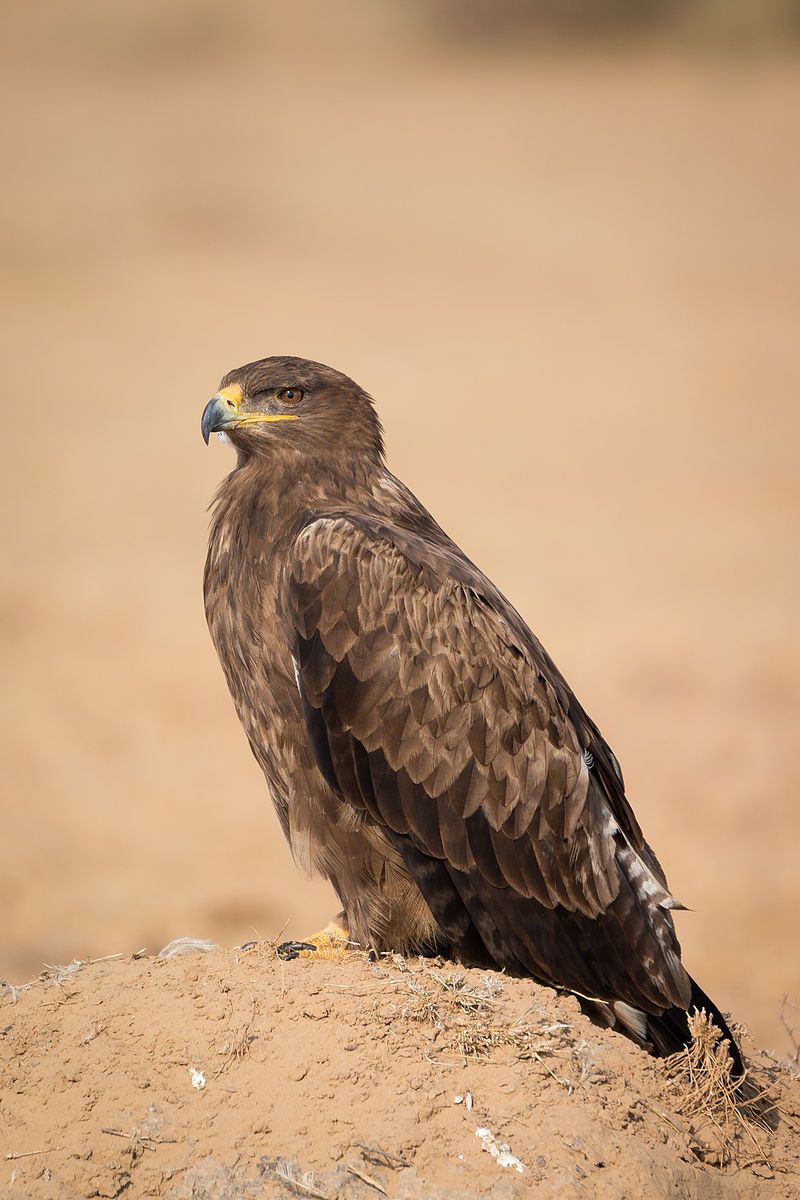
The steppe eagle is a large bird of prey that belongs to the family Accipitridae. This family comprises many birds, such as hawks, kites, and eagles. The steppe eagle is a member of the subfamily Aquilinae, also known as the “booted eagles.”
This name is derived from the fact that the steppe eagle, like other members of this subfamily, has well-feathered legs. This distinguishing feature helps to identify the steppe eagle from other birds of prey.
The steppe eagle is a species with a wide range throughout Eurasia, from the western edge of Europe to parts of Central Asia. It is a large raptor that feeds mainly on small mammals and birds and has a grayish-brown plumage with a white head and tail.
The males are smaller than the females and have darker plumage. The female can reach up to 28 inches long, while the male is slightly smaller. The steppe eagle is a mighty hunter capable of taking down large prey, such as hares, rabbits, and even foxes.
It has extraordinary eyesight and can spot its prey from quite a distance. It is also known to scavenge for food and has been observed stealing food from other birds of prey. Overall, the steppe eagle is a magnificent bird of prey well-adapted to its environment.
Its well-feathered legs help to identify it as a member of the subfamily Aquilinae, and its impressive hunting abilities make it one of the most respected raptors in the world.
| Kingdom | Animalia |
| Phylum | Chordata |
| Class | Aves |
| Order | Accipitriformes |
| Family | Accipitridae |
| Genus | Aquila |
| Species | A. nipalensis |
20. Great Bustard
The great bustard is a bird of the bustard family and is the only living member of the genus Otis. It is found in various habitats, from northern Morocco and South and Central Europe to temperate Central and East Asia.
It is a large bird, usually around 75-90 cm long, with a wingspan of up to two meters. The great bustard prefers open, grassy areas and farmland for breeding. It feeds mainly on insects, small reptiles, and plant matter.
It also consumes small birds, eggs, and other small animals. The great bustard is a sociable species, often found in flocks of up to 100 individuals. Due to its declining population, the great bustard is listed as Vulnerable on the IUCN Red List of Threatened Species.
The main threats to the species are habitat loss, hunting, and collisions with motor vehicles. Conservation efforts are focused on protecting its habitat and reducing the threats posed by human activities.
| Kingdom | Animalia |
| Phylum | Chordata |
| Class | Aves |
| Order | Otidiformes |
| Family | Otididae |
| Genus | Otis |
| Species | O. tarda |
21. Whooper Swan
The whooper swan (Cygnus cygnus) is a large water bird commonly found in the northern hemisphere. It is the Eurasian counterpart of the North American trumpeter swan and is the type species for the Cygnus genus.
The whooper swan is a graceful bird easily recognizable due to its large size, long neck, and white plumage. It has a black bill and legs and a distinctive yellow patch near the base of its bill. The whooper swan is more common in Europe and Asia than in North America.
It typically lives in shallow wetlands such as lakes, marshes, and bogs, feeding on aquatic plants, insects, and small fish. The whooper swan is a migratory species, with some populations traveling thousands of miles to reach wintering grounds.
It is also a social species, with flocks often gathering to feed and rest in the same area. The whooper swan is an important species in many cultures, appearing in mythology, literature, and art. Its beautiful call is also an iconic part of northern wetlands.
| Kingdom | Animalia |
| Phylum | Chordata |
| Class | Aves |
| Order | Anseriformes |
| Family | Anatidae |
| Genus | Cygnus |
| Species | C. cygnus |
22. Gadwall
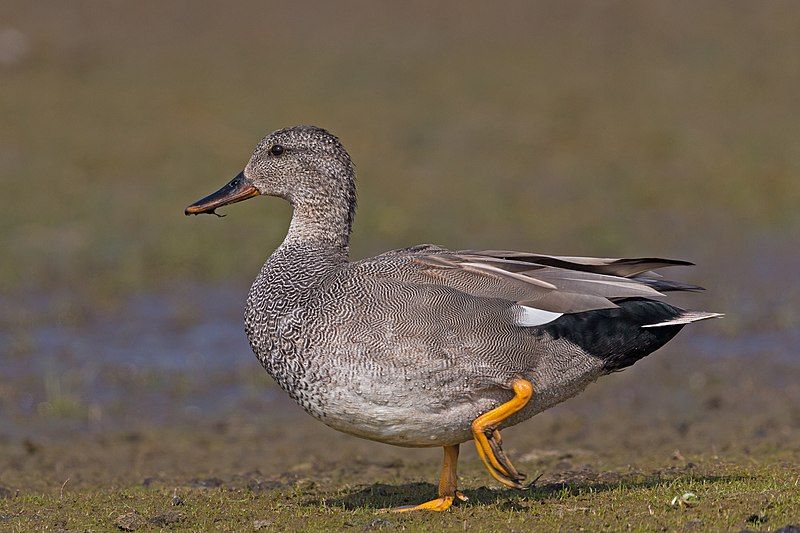
The gadwall is a species of duck found in the family Anatidae. It is a dabbling duck that feeds by tipping its head underwater to forage for food like aquatic plants and small aquatic invertebrates.
It is a medium-sized duck measuring 18 and 24 inches long and weighing between 1.2 and 2.2 pounds. It has a long, pointed bill and a grayish-brown body. It has a white undertail and a white triangle on its upper wings.
The male gadwall has a dark brown head and black back, while the female has a light brown head and grayish-brown back. The gadwall is a widespread species found on every continent except Antarctica.
It is most common in North America, Europe, and Asia and can be found in wetlands, lakes, and ponds. It is also commonly seen in large flocks that fly in V-shaped formations.
The gadwall can be seen in pairs on shallow wetlands during the breeding season. The gadwall is a species of most minor concern, meaning it is not threatened with extinction. Its population is stable and is not in danger of decline.
It is a famous game bird hunted in some parts of its range. It is also a valuable species in the wetlands, as it helps to control aquatic plant growth by foraging for food.
| Kingdom | Animalia |
| Phylum | Chordata |
| Class | Aves |
| Order | Anseriformes |
| Family | Anatidae |
| Genus | Mareca |
| Species | M. strepera |
23. Garganey
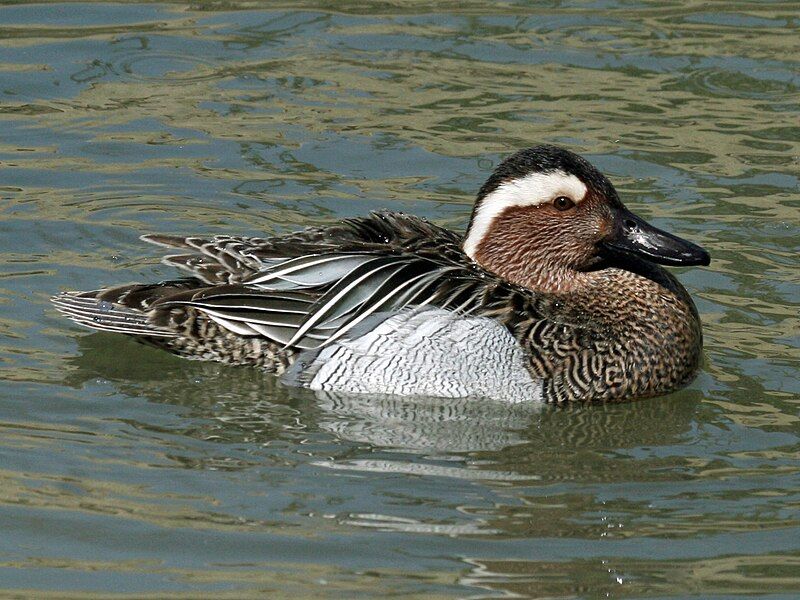
The garganey is a small dabbling duck spread across many parts of Europe and the Palearctic region. It is a strictly migratory bird whose entire population will migrate for the winter.
The garganey will fly to southern Africa, India, Bangladesh, and Australasia for the Northern hemisphere’s winter season. In these countries, large flocks of the garganey can be found.
The garganey will stay in these countries until the spring season in the Northern Hemisphere arrives, when they will then return to their original habitats.
This type of migration is necessary for the garganey to survive the cold winter months in the Northern Hemisphere.
| Kingdom | Animalia |
| Phylum | Chordata |
| Class | Aves |
| Order | Anseriformes |
| Family | Anatidae |
| Genus | Spatula |
| Species | S. querquedula |
24. Swan Goose
The swan goose is a large goose species found in East Asia and countries such as Mongolia, China, and Russia.
It is known for its migratory pattern, which sees it travel between its natural breeding range in inland Mongolia, Northeast China, and the Russian Far East, and its wintering grounds in central and eastern China.
The swan goose is an essential species in the region, as it provides an important food source for local people and is an integral component of local ecosystems.
Its migratory pattern also helps to spread nutrients around the region, as the birds carry food and other matter with them as they travel.
| Kingdom | Animalia |
| Phylum | Chordata |
| Class | Aves |
| Order | Anseriformes |
| Family | Anatidae |
| Genus | Anser |
| Species | A. cygnoides |
Conclusion
The birds of South Kazakhstan are a diverse and fascinating group of species. From the majestic and awe-inspiring Golden Eagle to the small and colorful finches, there is something for everyone to enjoy in this beautiful part of the world.
There is still much research on the birds of South Kazakhstan, and conservation efforts are needed to ensure these species are protected for future generations.
With exemplary conservation efforts, the birds of South Kazakhstan can continue to bring joy and wonder to people for many years to come.